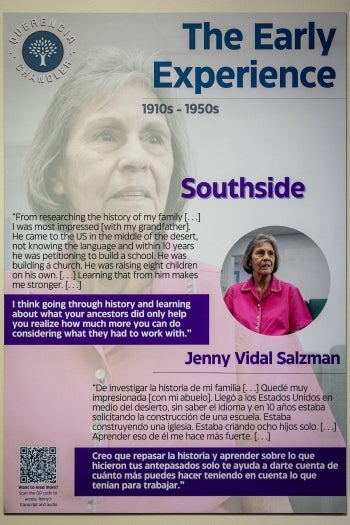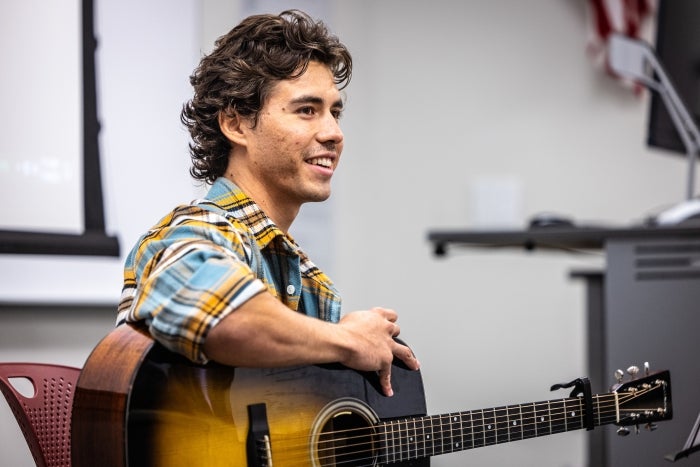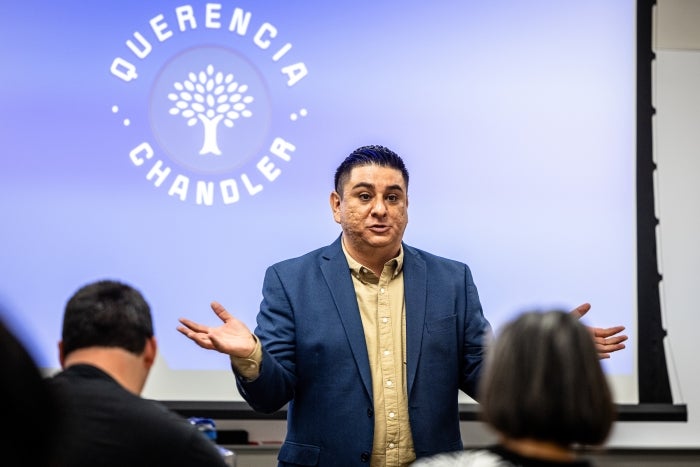Students bridge past, present in Chandler history exhibit

Operations manager Brett Kennedy positions posters for hanging as he installs "Querencia: Place and Belonging in Chandler" on Monday, Nov. 27, in the ASU Chandler Innovation Center. This community-focused exhibition, created partly by ASU Assistant Professor Rafael Martínez, presents the oral histories of long-term Hispanic and Latino residents in Chandler’s historic barrios, alongside recent migrant communities. Photo by Charlie Leight/ASU News
As Jenny Vidal Salzman looked at the 12 sign boards featuring portraits and short bios of Chandler residents, past and present, she found herself in an uncommon situation — staring back at herself.
Salzman is one of 12 subjects that are part of an oral project by Arizona State University's History of the American Southwest class, where students creatively interpreted the life stories of the people featured.
Each interviewee has their own storyboard along with a QR code that allows viewers to download the accompanying student’s rendition of that oral history.
It's part of the "Querencia: Place and Belonging in Chandler" exhibit, now on display at the ASU Chandler Innovation Center after spending a month in the Chandler Museum.
“You normally don’t get to hear your life story being told by someone else and shared like this,” Salzman said. “The students did a really good job.”
"Querencia" is a community-based project aimed at collecting the oral histories of long-term Latino residents in Chandler's historic neighborhoods and recent Latino migrant communities. The goal: to provide historical context to current and future generations in an effort to effect positive change through insight.
Salzman, 77, who identifies as Mexican American, entrusted her story to ASU fourth-year student Scott Harvey. Salzman’s story included anecdotes about growing up in a home with an outhouse and no hot water, her father’s strong work ethic and the El Mambo Club on Frye Road, a venue where Mexican Americans gathered for celebrations.
“When you’re telling someone’s life story and they’re right here, you want to get it right,” said Harvey, who is pursuing a degree in applied psychological science.
Stories worth listening to
The students presented their projects during an opening reception held at the center on Nov. 30.
ASU student Ebony Koger created a comic strip to tell the story of Alberto Esparza, founder of the Si Se Puede Foundation, a nonprofit organization that facilitates programs that provide resources and support to low-income, predominantly minority communities in Chandler and Phoenix.
Koger enlisted the help of friend and professional illustrator Jonathan McEwen and provided narration that covered the span of Esparza’s childhood in West Phoenix, where he grew up as the only Latino in a predominantly African American school, to college, where he received a criminal justice degree from ASU and a master’s degree in education from Northern Arizona University.
“You know how you hear those ‘I started from nothing’ type of stories? I thought, let's put a little spin to it,” said Koger, a third-year transfer student from Mesa Community College who is pursuing a degree in history with a certificate in African and African American studies.
Ryan Brady, a junior pursuing a degree in operations management, wrote an original song for his project on Alex Ramos, which he sang while playing the acoustic guitar.
Brady, who was born and raised in Chandler and — like his subject, Ramos — is the child of an immigrant, said he could relate to many of the situations and oral histories shared in the “Querencia” exhibit.
“That’s the main point of this project — to see the development and history. So being from (Chandler) gives me that lens into the past,” Brady said.
Filling a niche
The story subjects include men and women ranging in age from 19 to 77 — representing time periods spanning from early settlers' experiences in 1912 through the Civil Rights Movement to the current era of development and growth.
The goal was to have a range of generations, said Assistant Professor Rafael Martinez from ASU’s College of Integrative Sciences and Arts.
The narratives include a range of personal stories that touch on racism, segregation and poverty, and how sometimes these issues could strengthen family ties, inspire people to pursue their dreams and create a special bond among neighbors.
As a historian, Martinez believes in the power of public history projects and wanted to connect ASU research and the community.
“Not much had been written about LatinxThe gender-neutral term for Latinos/as. populations in the historical record in the southeast Valley. I thought that was an important niche to fill,” Martinez said.
Engaging with the past for a better future
The project is the culmination of three years of work and collaboration between Martinez and Kristine Clark, a community engagement specialist at the Chandler Museum.
“(Martinez) collected stories, but where do those live from there? That’s where the museum came in,” Clark said. “He was of the mentality, ‘I want my students to learn hands-on history.’”
The Chandler Museum’s capacity to store physical documents like newspaper clippings and photographs, as well as digital records, allowed the museum to archive the materials collected from the project. A city of Chandler Diversity, Equity and Inclusion Division grant provided funding for the project.
From the start, Clark and Martinez envisioned “Querencia” being a traveling exhibit throughout various venues in Chandler. Clark said she sees the exhibit’s potential to grow and expects it to get bigger each year.
“I think it’s very exciting. Seeing these two institutions trying to give more voice to this community, I think is immeasurable,” Clark said. “It’s one thing for grandma to tell me a story about the ‘50s. But when grandma’s story is on the wall, it takes it to another level of importance.”
The “Querencia” exhibit will be on display at the ASU Chandler Innovation Center through the spring 2024 semester.
“By building public history projects, we can get people from diverse backgrounds and walks of life to be able to engage and learn about this history through this particular exhibit,” Martinez said. “One of my aspirations was to preserve that history for the generations of Lantix people and other ethnic communities as this place continues to transform and grow. My hope is we can make better informed decisions if we are engaged with this history.”
Written by Georgann Yara
More Arts, humanities and education

ASU alumna makes her way back to the ASU Gammage stage for '¡azúcar!'
As the Los Angeles-based CONTRA-TIEMPO dance group prepares for its upcoming production “¡azúcar!” at ASU Gammage, for one member of the dance group it is also a nostalgic return to her home.Born in…

ASU FIDM professor wins international award for fantastical, sustainable creation
The horror of an ailing Earth inspired an Arizona State University fashion professor to create a fantastical garment out of sustainable, re-used and found materials that won a prestigious…

ASU workshop trains educators, professionals from marginalized communities in disaster science
As devastating as hurricanes can be to anyone caught in their paths, they strike marginalized communities even harder.To address this issue, a fund named for a former Arizona State University…



